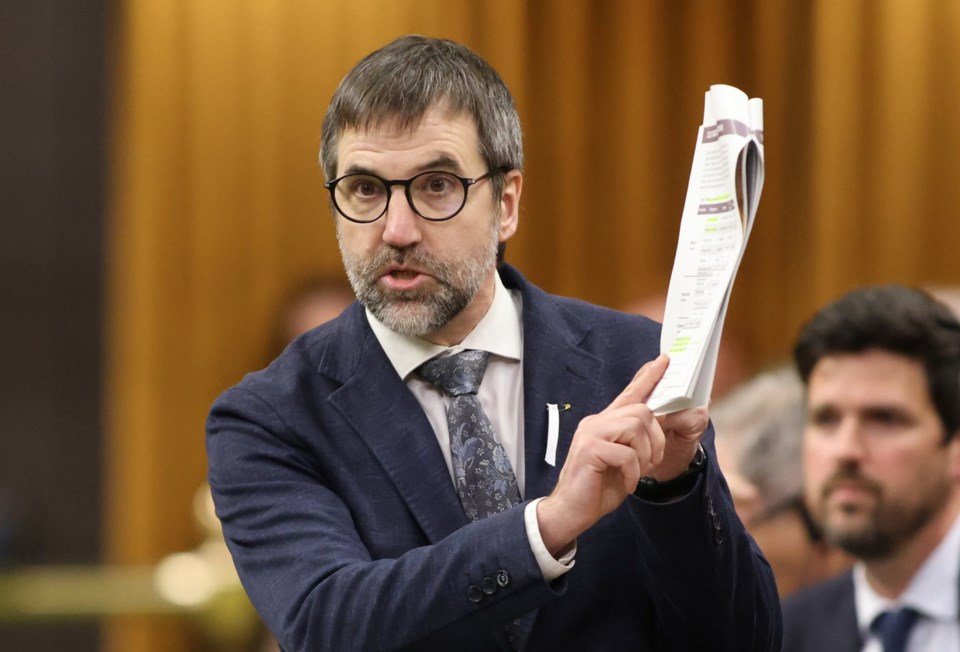TORONTO — Canada is aiming to cut its emissions in half by 2035 compared to 2005 levels, the federal government announced Thursday, a target more modest than what a federal advisory body had previously recommended.
The target of reducing emissions by 45 to 50 per cent balances both ambition and achievability, Environment and Climate Change Minister Steven Guilbeault said in an interview.
"I think it's important to send a signal to the Canadians, Canadian businesses, provinces, municipalities and other stakeholders who care deeply about this, that we're continuing on the fight against climate change in Canada," he said.
He added that the target's lower end accounts for potential headwinds, including how United States president-elect Donald Trump approaches key climate policies.
Trump has called climate change a hoax and promised to roll back legislation that funnels money to green energy projects in his second term. Last time he was in office, he pulled the U.S. out of a major United Nations climate pact.
"As a responsible government, we have to account for the possibilities that it may be more difficult in the coming years to continue moving forward because our major trading partner may decide to take a different course when it comes to tackling climate change," Guilbeault said.
In a report published in September, Canada's Net-Zero Advisory Body recommended an emissions reduction target of 50 to 55 per cent.
The report says a target in the government's chosen range of 45 to 50 per cent would risk "putting Canada too far behind its net-zero goal and would likely represent insufficient ambition" compared to its partners, including other G7 countries.
Catherine Abreu, a climate policy analyst, called the target "pathetic" and out of step with the United Kingdom's and Japan's more ambitious goals, despite volatile U.S. politics.
"I think with this target, we're seeing Canada have a much more extreme reaction to that political volatility than any other G7 country. This target is really going to make Canada stick out like a sore thumb," said Abreu, who sits on the advisory body, but was not speaking on its behalf.
Federal legislation required Ottawa to set the target this month as one of its checkpoints on the path to Canada's goal to achieve net zero by 2050, which means achieving an even balance between emissions that are put into the atmosphere versus emissions that are captured and neutralized.
Global emissions need to hit net zero by around mid-century if the world wants to limit global warming to around 1.5 C and avert some of climate change's most severe impacts, according to the Intergovernmental Panel on Climate Change, a scientific body of the United Nations.
Canada's advisory body has said the government is already at risk of missing its 2030 target of a 40 to 45 per cent emissions cut, even if it implements all of its current climate plans.
Guilbeault said his Liberal government has "done a lot in the last few years, but there's still a long way to go."
Several of the government's existing or planned policies intended to reduce emissions have come under fire from Conservative opposition. That includes the consumer carbon price and a proposed emissions cap on the oil and gas industry.
The target released Thursday received mixed reception by others in Canada's climate policy circles.
It is a "reasonable" approach, said Mark Zacharias, executive director at Clean Energy Canada, a climate and clean energy think tank at Simon Fraser University.
He said provinces will also have to step up with actions to drive down emissions, such as policies to increase adoption of energy efficient heat pumps and electric vehicles.
"Setting a target that you can meet actually allows you to back calculate around what ... policies you need in place to get there, and it becomes a very, very reasonable discussion around how to get to a particular target," said Zacharias.
It's not good enough, suggested Caroline Brouillette, executive director of Climate Action Network Canada, a network of climate advocacy groups.
She called the new target "weak."
"The federal government could have used this target to set a bold vision to diversify our economy towards affordable, reliable energy sources, and reduce our dependence on the whims of belligerent climate deniers," she wrote in a statement.
"Instead, it has chosen to cave."
This report by The Canadian Press was first published Dec. 12, 2024.
Jordan Omstead, The Canadian Press



